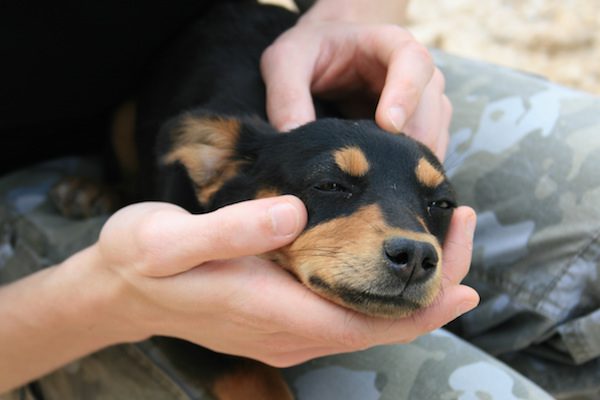Just like people, dogs can get flu and more and more dogs are coming down with canine influenza as the illness has emerged and spread throughout North America in just the past 6 years. And just like with people, the infectious respiratory disease can range from mild symptoms to potentially life-threatening ones.
So what are the symptoms to look out for and what should you do to prevent your dog getting sick, or if he/she does, how should you care for them?
What is dog flu?
Canine Influenza, otherwise known as dog flu, was first seen in the United States in 2004 in racing greyhounds in Florida. The CIV H3N8 strain has now spread to over 38 states and commonly occurs in the canine population. Genetic analysis shows the virus is closely related to equine influenza, and as greyhounds and race horses often are around the same racetracks, speculation is that canine influenza evolved from the equine virus and jumped from horses to dogs.
In 2015, an outbreak of a new strain of dog flu emerged. This strain referred to as CIV H3N2 is of avian origin and not related to the earlier CIV H3N8 virus.
Dogs of any age can be affected, and because the viruses are relatively new, there is little to no natural immunity in the canine population. Virtually all dogs that are exposed to the virus become infected and nearly 80% show clinical signs of disease. The virus is highly contagious, but thankfully has a low mortality rate. There is no “season” for it, and it spreads year round. Dogs highest at risk are those grouped together, the very young, the very old and the immune-compromised. The disease does not affect humans.
The virus spreads through respiratory secretions (e.g. saliva and mucous) and contaminated objects and surfaces (e.g. kennel surfaces, food, water bowls, collars and leashes). People also spread it moving between infected and uninfected dogs without proper precautions or hygiene.

Wikimedia
Often outbreaks are reported more frequently at facilities that have dogs closely congregated together such as greyhound racetracks, kennels, pounds and shelters, but the virus can be picked up anywhere. The virus remains alive and infectious on surfaces for up to 48 hours, on clothing for 24 hours, and on hands for 12 hours.
Symptoms
Symptoms of dog flu are similar to those of kennel cough and can be easily mistaken for kennel cough without laboratory testing. Once a dog has picked up the virus, it takes usually two to five days for a dog to start evincing symptoms.
Mild symptoms include a persistent cough (which can last anywhere from 10 to 30 days) and nasal discharge/snot (usually greenish in color). In the milder form of the disease, a thick green nasal discharge most likely represents a secondary bacterial infection and usually resolves quickly after treatment with antibiotics.
Severe symptoms of the disease include fever (104ºF to 106ºF) and respiratory distress. Complications can ensue if a dog gets a secondary bacterial infection, which can lead to pneumonia.
If this happens, hospitalization and aggressive treatment of the disease is required. Hydration (sometimes via intravenous administration of fluids) and a broad-spectrum bactericidal antimicrobial will be administered. Fortunately, most dogs affected by canine influenza develop the mild form.
What to do if your dog shows symptoms?
If you suspect your dog has contracted dog flu, schedule an appointment with your veterinarian so that he or she can examine and evaluate your dog and recommend an appropriate course of treatment. As mild cases usually clear up on their own, treatment is similar to what would be recommended for a person – simple tender loving care.
- Keep the dog warm (avoiding chilly floors and rooms such as those usually found in the garage or basement), hydrated and rested.
- Keep the dog at home and away from other dogs! An infected dog should be isolated from other dogs to prevent spread of the infection. So visiting a dog park, sharing water and food bowls, or going to doggie daycare should be avoided!
- Keep affected surfaces and clothing clean, especially if you have other dogs in the home. Clothing, equipment, surfaces, and hands should be cleaned and disinfected regularly and methodically. Clothing can be washed with regular detergent and warm (or hot) laundry temperatures. Bleach will disinfect surfaces (such as cages, kennels, collars or leashes) effectively.
- Wash your hands with soap and water before and after handling a dog, and after coming into contact with an infected dog’s saliva, urine, or feces.
- Antibiotics may be prescribed to clear up nasal discharge.
- Most dogs will recover in two to four weeks.
- If your dog does not show signs of improvement after a week or so and symptoms become more severe, revisiting the vet is strongly recommended. Remember the cough can persist for some time (up to a month).
Prevention
To reduce the risk of your dog contracting dog flu, follow good infection control practices. Avoid letting your dog drink from communal water bowls (such as those located at parks, cafes or pet shops). Be aware of any outbreaks in your local community and if an outbreak occurs in an area you frequent, avoid exposing your dog to that area temporarily.
If you plan to leave your dog at a boarding facility or kennel ask whether respiratory disease has been a problem and if they have a plan of action for any potential cases that may arise.
If your dog is involved in shows, sports and other activities where he or she interacts with lots of other dogs regularly you may consider vaccination. There may be other considerations regarding your dog’s health (e.g. they have a compromised immune system or a pre-existing medical condition) that also may warrant administering a preventative vaccine. Consult your veterinarian about the vaccination.
Like the human vaccine, it may not prevent entirely, but may lessen the severity and duration of the flu. Vaccinated dogs will also have a shorter contagious period. The current vaccine must be given twice initially with a two-week break, then annually thereafter. Because any vaccine can have negative side effects on some dogs, many dog owners choose not to vaccinate against the flu.
Most dogs recover from the flu with mild symptoms, and research indicates that dogs that has recovered from canine influenza appear to have boosted immunity for at least two years.
Share this information with your dog-loving friends so they will know more about dog flu.
Disclosure: This post may include affiliate links.
